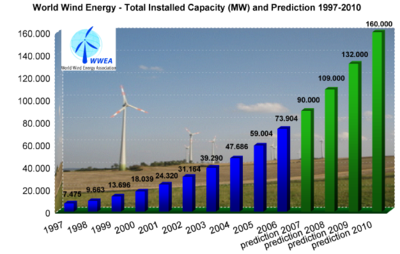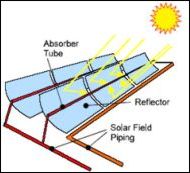Renewable energy commercialization: Difference between revisions
mNo edit summary |
adding para |
||
| Line 2: | Line 2: | ||
[[Renewable energy]] technologies are essential contributors to the energy supply portfolio as they generally contribute to world [[energy security]], reducing dependency on [[fossil fuel]] resources, and providing opportunities for mitigating [[greenhouse gases]].<ref>[http://www.iea.org/textbase/papers/2006/renewable_factsheet.pdf Renewables in global energy supply: An IEA facts sheet]</ref> |
[[Renewable energy]] technologies are essential contributors to the energy supply portfolio as they generally contribute to world [[energy security]], reducing dependency on [[fossil fuel]] resources, and providing opportunities for mitigating [[greenhouse gases]].<ref>[http://www.iea.org/textbase/papers/2006/renewable_factsheet.pdf Renewables in global energy supply: An IEA facts sheet]</ref> |
||
Renewable energy systems encompass a broad, diverse array of technologies, including solar photovoltaics, solar thermal power plants and heating/cooling systems, wind, hydroelectricity, geothermal, biomass, and ocean power systems. The current status of these different technologies varies considerably. Some technologies are already mature and economically competitive, other technologies need only limited additional development steps to become ready for the market, and yet other technologies are still too expensive and may require a few decades of continued R&D efforts in order to make large contributions on a global scale.<ref>[http://www.icsu.org/Gestion/img/ICSU_DOC_DOWNLOAD/858_DD_FILE_CSD-14_Discussion_paper.pdf Discussion Paper by the Scientific and Technological Community for the 14th session of the |
|||
United Nations Commission on Sustainable Development (CSD-14)]</ref> |
|||
The [[International Energy Agency]] has explained that it is possible to define three generations of renewable energy technologies, reaching back more than 100 years:<ref>[http://www.iea.org/textbase/papers/2006/renewable_factsheet.pdf Renewables in global energy supply: An IEA facts sheet]</ref> |
The [[International Energy Agency]] has explained that it is possible to define three generations of renewable energy technologies, reaching back more than 100 years:<ref>[http://www.iea.org/textbase/papers/2006/renewable_factsheet.pdf Renewables in global energy supply: An IEA facts sheet]</ref> |
||
Revision as of 22:24, 21 April 2007
| Part of a series on |
| Renewable energy |
|---|
 |
Renewable energy technologies are essential contributors to the energy supply portfolio as they generally contribute to world energy security, reducing dependency on fossil fuel resources, and providing opportunities for mitigating greenhouse gases.[1]
Renewable energy systems encompass a broad, diverse array of technologies, including solar photovoltaics, solar thermal power plants and heating/cooling systems, wind, hydroelectricity, geothermal, biomass, and ocean power systems. The current status of these different technologies varies considerably. Some technologies are already mature and economically competitive, other technologies need only limited additional development steps to become ready for the market, and yet other technologies are still too expensive and may require a few decades of continued R&D efforts in order to make large contributions on a global scale.[2]
The International Energy Agency has explained that it is possible to define three generations of renewable energy technologies, reaching back more than 100 years:[3]
- First-generation technologies emerged from the industrial revolution at the end of the 19th century and include hydropower, biomass combustion, and geothermal power and heat. Some of these technologies are still in widespread use.
- Second-generation technologies include solar heating and cooling, wind power, modern forms of bioenergy, and solar photovoltaics. These are now entering markets as a result of research, development and demonstration (RD&D) investments since the 1980s. The initial investment was prompted by energy security concerns linked to the oil crises of that period but the continuing appeal of renewables is due, at least in part, to environmental benefits. Many of the technologies reflect significant advancements in materials.
- Third-generation technologies are still under development and include advanced biomass gasification, biorefinery technologies, concentrating solar thermal power, hot-dry-rock geothermal power, and ocean energy. Advances in nanotechnology may also play a major role.[4]
First- and second-generation technologies have entered the markets, and third-generation technologies heavily depend on long term RD&D commitments, where the public sector has a role to play.[5]
Market considerations
First-generation technologies

First-generation technologies are most competitive in locations with abundant resources. Their future use depends on the exploration of the remaining resource potential, particularly in developing countries, and on overcoming challenges related to the environment and social acceptance. For example, there are several significant environmental disadvantages of large-scale hydroelectric power systems, which include: dislocation of people living where the reservoirs are planned, release of significant amounts of carbon dioxide at construction and flooding of the reservoir, and disruption of aquatic ecosystems and birdlife.[6] Hydroelectric power is now more difficult to site in developed nations because most major sites within these nations are either already being exploited or may be unavailable for these environmental reasons (See Hydroelectricity article for details).
Second-generation technologies

Markets for second-generation technologies are strong and growing, mainly in countries such as Germany, Spain, the United States, and Japan. The challenge is to broaden the market base for continued growth worldwide. Strategic deployment in one country not only reduces technology costs for users there, but also for those in other countries, contributing to overall cost reductions and performance improvement.[7]
This has been the case for photovoltaics. In the 1980s and early 1990s, most photovoltaic modules provided Remote Area Power Supply, but from around 1995, industry efforts have focused increasingly on developing building integrated photovoltaics and power plants for grid connected applications (see Photovoltaics article for details). There is currently a proposal to build a Solar power station in Victoria, Australia, which would be the world's largest PV power station, at 154MW.[8]
Some of the second-generation renewables, such as wind, have high potential and have already realised relatively low production costs. At the end of 2006, worldwide capacity of wind-powered generators was 74,223 megawatts, and although it currently produces less than 1% of world-wide electricity use, it accounts for approximately 18% of electricity use in Denmark, 9% in Spain, and 7% in Germany.[9]. However, it may be difficult to site wind turbines in some areas for aesthetic or environmental reasons, and it may be difficult to integrate wind power into electricity grids in some cases.[10] (see also Wind Power article).

Solar heating systems are a well known second-generation technology and are generally composed of solar thermal collectors, a fluid system to move the heat from the collector to its point of usage, and a reservoir or tank for heat storage and subsequent use. The systems may be used to heat domestic hot water, swimming pool water, or for space heating.[11] The heat can also be used for industrial applications or as an energy input for other uses such as cooling equipment.[12] In many climates, a solar heating system can provide a very high percentage (50 to 75%) of domestic hot water energy. In many northern European countries, combined hot water and space heating systems (solar combisystems) are used to provide 15 to 25% of home heating energy (see Solar hot water article).
Third-generation technologies

Third-generation technologies are still under development and include advanced biomass gasification, biorefinery technologies, concentrating solar thermal power, hot-dry-rock geothermal power, and ocean energy.[13]
Third-generation technologies are not yet widely demonstrated or have limited commercialization. Many are on the horizon and may have potential comparable to other renewable energy technologies, but still depend on attracting sufficient attention and RD&D funding.[14] However, solar thermal power stations have been successfully operating in California commercially since the late 1980s, including the largest solar power plant of any kind, the 350 MW Solar Energy Generating Systems. Nevada Solar One is another 64MW plant which is about to open.[15] Other parabolic trough power plants being proposed are two 50MW plants in Spain (see Solar power in Spain), and a 100MW plant in Israel.[16]
In terms of Ocean energy, another third-generation technology, Portugal has the world's first commercial wave farm, the Aguçadora Wave Park, established in 2006. The farm will initially use three Pelmis P-750 machines generating 2.25 MW.[17] [18] Initial costs are put at 8,5 million euro. Subject to successful operation, a further 70 million euro is likely to be invested before 2009 on a further 28 machines to generate 525 MW.[19] Funding for a wave farm in Scotland was announced in February, 2007 by the Scottish Executive, at a cost of over 4 million pounds, as part of a £13 million funding packages for ocean power in Scotland. The farm will be the world's largest with a capacity of 3MW generated by four Pelamis machines.[20] (see also Wave farm).
See also
- Deployment of solar power to energy grids
- List of wind turbine manufacturers
- National Renewable Energy Laboratory
- Photovoltaics
- Renewable energy
- Renewable energy commercialization in Australia
- Renewable energy in Germany
- Renewable energy in Portugal
- Renewable energy in Scotland
- Renewable energy in the European Union
- Solar cell
- Solar power in Australia
- Solar power in Spain
- Solar power plants in the Mojave Desert
- Solar power tower
- Waldpolenz Solar Park in Saxony, Germany
- Wave farm
- Wind power
- Wind power in Australia
- Wind power in Germany
- Wind power in Spain
- Wind power in the United Kingdom
References
- ^ Renewables in global energy supply: An IEA facts sheet
- ^ [http://www.icsu.org/Gestion/img/ICSU_DOC_DOWNLOAD/858_DD_FILE_CSD-14_Discussion_paper.pdf Discussion Paper by the Scientific and Technological Community for the 14th session of the United Nations Commission on Sustainable Development (CSD-14)]
- ^ Renewables in global energy supply: An IEA facts sheet
- ^ Renewables in global energy supply: An IEA facts sheet
- ^ Renewables in global energy supply: An IEA facts sheet
- ^ Hydroelectric power's dirty secret revealed
- ^ Renewables in global energy supply: An IEA facts sheet
- ^ Solar Systems projects
- ^ Global wind energy markets continue to boom – 2006 another record year
- ^ Renewables in global energy supply: An IEA facts sheet
- ^ Solar water heating
- ^ Solar assisted air-conditioning of buildings
- ^ Renewables in global energy supply: An IEA facts sheet
- ^ Renewables in global energy supply: An IEA facts sheet
- ^ Solar One is "go" for launch
- ^ Israeli company drives the largest solar plant in the world
- ^ Sea machine makes waves in Europe
- ^ Wave energy contract goes abroad
- ^ Primeiro parque mundial de ondas na Póvoa de Varzim
- ^ Orkney to get 'biggest' wave farm
Bibliography
- International Energy Agency (2007). Renewables in global energy supply: An IEA facts sheet, OECD, 34 pages.
External links
- Sunny outlook for solar power players
- Renewable energy commercialisation in Australia
- Solar Systems to Build A$420 million, 154MW Solar Power Plant in Australia
- BP solar to expand its solar cell plants
- Australia's largest city solar project contract awarded
- Nevada Solar One video
- 40MW German solar park
- Building-integrated PV systems
- Major solar plant opens in Portugal
- Windfarms to power a third of London homes
- Renewable energy in Scotland
- American energy: The renewable path to energy security
- Distributed Energy -- The Journal for Onsite Power Solutions
